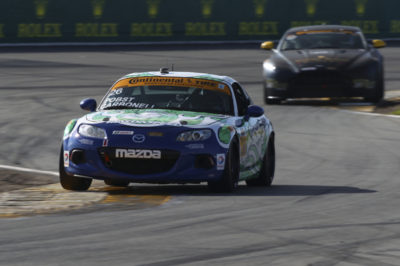Most Club Racers will experience traffic in every race. With multiple classes on the circuit at once, racers are going to be passed by or be passing other cars in different classes on a regular basis. A Spec Miata or STL driver might be on track with Performance Touring A or Touring 2 cars, meaning that being passed by faster cars will happen somewhat frequently.
Randy Pobst knows a thing or two about that. A two-time GT class winner in the Rolex 24 at Daytona, he’s used to getting passed by prototypes. Now driving the No. 26 Freedom Autosport MX-5 in the Continental Tire SportsCar Challenge Street Tuner class, he has to deal with the faster Grand Sport-class cars every time he goes out on track.
“First and foremost, you need total awareness of traffic that’s coming up from behind. And that requires checking the mirrors out of every corner,” he explains. “A great trick for getting lapped is to make every effort to get the other cars through before the corner or after the corner and drive through the corner single file, either leading them or following them. Another way of saying that, or a general philosophy, is to make yourself easier to pass for the faster cars. In this case, the MX-5 blends very well, because it’s as fast as any car in the corners, and the GS cars have a couple hundred horsepower on us, so most of the time those passes happen on the straightaways.”
It’s a good idea to assume, he says, that where there is one car, there’s a good chance that there are two or three more on its tail. The faster cars are racing as well, so they tend to travel in packs.
It’s one thing to say, “Be easy to pass.” But that changes radically when a driver being lapped by faster traffic is in his or her own race as well. It’s nice to let the faster class cars through, but few will want to risk their own chances of victory in the process.
“The highest priority is my race and my goal to win this race,” Pobst says. “So I have to blend those two together. I do what I can, but there’s a limit. So I make that decision based on where I am. If I’m running down the lead and I’ve almost got him and it’s really crucial, I’m going to insert myself between those cars and do my best for my own lap time.”
Where someone is being lapped, someone else is doing the lapping. For the driver in that situation, passing slower traffic has its perils, but also its benefits.
“I’ve been in the slower class, so when I’m in a car that’s an overall car, I have respect for those guys. I know how hard they’re racing, so I do my best not to mess up their race. And sometimes I can use the slower cars as kind of a pick to hold up my competitor,” Pobst says.
“My choices of when to be aggressive about a pass depends on the performance of the other cars. I’m making constant decisions on where to take the slower cars so it hurts my lap time the least. If I’m catching a Miata right before a section of tight curves, I don’t make a strong effort to get by; I know I can follow. But if I’m catching a Miata right before a long straightaway, I make an effort to get by so I can get a clean shot off the corner.”
In short, it takes a lot of patience, understanding and courtesy to co-exist on a track with different classes of cars. It’s one of the challenges of multi-category endurance racing, and a test most club racers face every time they go on track.



 ACCESSIBILITY
ACCESSIBILITY